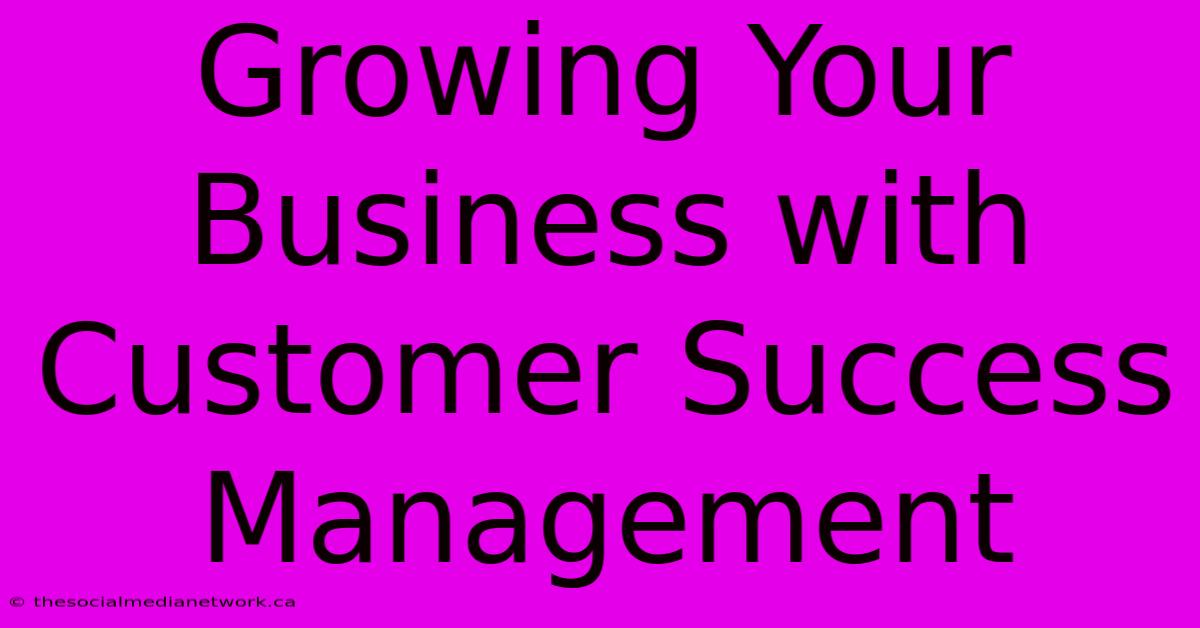Growing Your Business With Customer Success Management

Discover more detailed and exciting information on our website. Click the link below to start your adventure: Visit Best Website meltwatermedia.ca. Don't miss out!
Table of Contents
Growing Your Business with Customer Success Management
Are you tired of seeing customers churn and feeling like your business isn't reaching its full potential? The secret ingredient might be hiding in plain sight: Customer Success Management (CSM). While customer service focuses on immediate issue resolution, CSM is a proactive, strategic approach focused on long-term customer relationships and sustainable growth. This article explores how implementing a robust CSM strategy can significantly boost your business.
What is Customer Success Management (CSM)?
Customer Success Management isn't just about happy customers; it's about driving customer outcomes and ensuring they achieve their desired results using your product or service. It's a data-driven approach that involves:
- Understanding customer needs: Deeply understanding your customers' goals and how your offering helps them achieve those goals.
- Proactive engagement: Reaching out to customers regularly, not just when there's a problem. This could involve check-in calls, onboarding support, or educational resources.
- Personalized experiences: Tailoring interactions and support to individual customer needs and preferences.
- Data-driven insights: Tracking key metrics (like customer health scores and Net Promoter Scores) to identify at-risk customers and proactively address potential issues.
- Continuous improvement: Regularly reviewing your CSM strategy and making adjustments based on data and customer feedback.
How CSM Drives Business Growth
A well-executed CSM strategy directly contributes to several key areas of business growth:
-
Increased Customer Retention: By proactively addressing customer needs and ensuring they are getting value from your product or service, you dramatically reduce churn. Imagine a SaaS company using CSM to identify struggling users early on; proactive intervention through tailored training or support could turn a potentially lost customer into a long-term advocate.
-
Improved Customer Lifetime Value (CLTV): Happy, successful customers tend to stay longer and spend more. CSM helps nurture these relationships, leading to increased CLTV.
-
Enhanced Brand Advocacy: When customers feel understood and valued, they are more likely to recommend your business to others. This organic word-of-mouth marketing is invaluable.
-
Increased Revenue and Profitability: By focusing on customer success, you indirectly increase revenue through higher retention, upselling opportunities, and positive referrals.
-
Valuable Feedback for Product Development: Closely working with customers provides invaluable feedback that can inform product development and roadmap prioritization, ensuring your offerings remain relevant and competitive.
Implementing a Successful CSM Strategy
Building a successful CSM program requires careful planning and execution. Here are some key steps:
- Define your ideal customer profile (ICP): Understand the characteristics of your most successful customers.
- Set clear customer success metrics: Track metrics that align with your business goals, such as customer churn rate, customer satisfaction (CSAT), and Net Promoter Score (NPS).
- Develop a customer onboarding plan: Ensure a smooth and effective onboarding experience for new customers.
- Invest in the right tools and technology: Utilize CSM platforms to manage customer interactions, track metrics, and automate tasks.
- Build a high-performing CSM team: Recruit and train dedicated customer success managers who are empathetic, proactive, and data-driven.
Real-life Example: The Power of Proactive Engagement
Imagine a software company using CSM. Instead of waiting for support tickets, they proactively reach out to new users within the first week to offer onboarding assistance and answer any initial questions. This personalized touch significantly improves user experience and reduces the likelihood of early churn.
Frequently Asked Questions (FAQs)
-
Q: What's the difference between CSM and customer service? A: Customer service addresses immediate issues, while CSM proactively works to ensure long-term customer success and value realization.
-
Q: Is CSM only for SaaS companies? A: No, CSM principles can be applied to any business model where building strong customer relationships is crucial for growth.
-
Q: How do I measure the ROI of CSM? A: Track metrics like customer churn rate, CLTV, and revenue generated from upselling and referrals.
-
Q: What are some common CSM tools? A: Popular tools include Gainsight, Totango, and ChurnZero. However, the best tool will depend on your specific needs and business size.
-
Q: How can I get started with CSM? A: Begin by defining your ICP, setting clear goals, and identifying a few key metrics to track. Start small and gradually expand your program as you gain experience.
By implementing a robust Customer Success Management strategy, businesses can foster lasting customer relationships, drive revenue growth, and build a thriving, sustainable enterprise. The investment in proactive engagement and personalized support will undoubtedly yield significant returns in the long run.

Thank you for visiting our website wich cover about Growing Your Business With Customer Success Management. We hope the information provided has been useful to you. Feel free to contact us if you have any questions or need further assistance. See you next time and dont miss to bookmark.
Featured Posts
-
Amorims Serie A Raid A Smart Move
Dec 02, 2024
-
Future Scope Customer Engagement Platforms
Dec 02, 2024
-
Food And Beverage Market Report 2024 2033 Nestle
Dec 02, 2024
-
Premier League Liverpools Slot Machine Vs Citys Crisis
Dec 02, 2024
-
Clippers Secure Victory Over Nuggets
Dec 02, 2024
